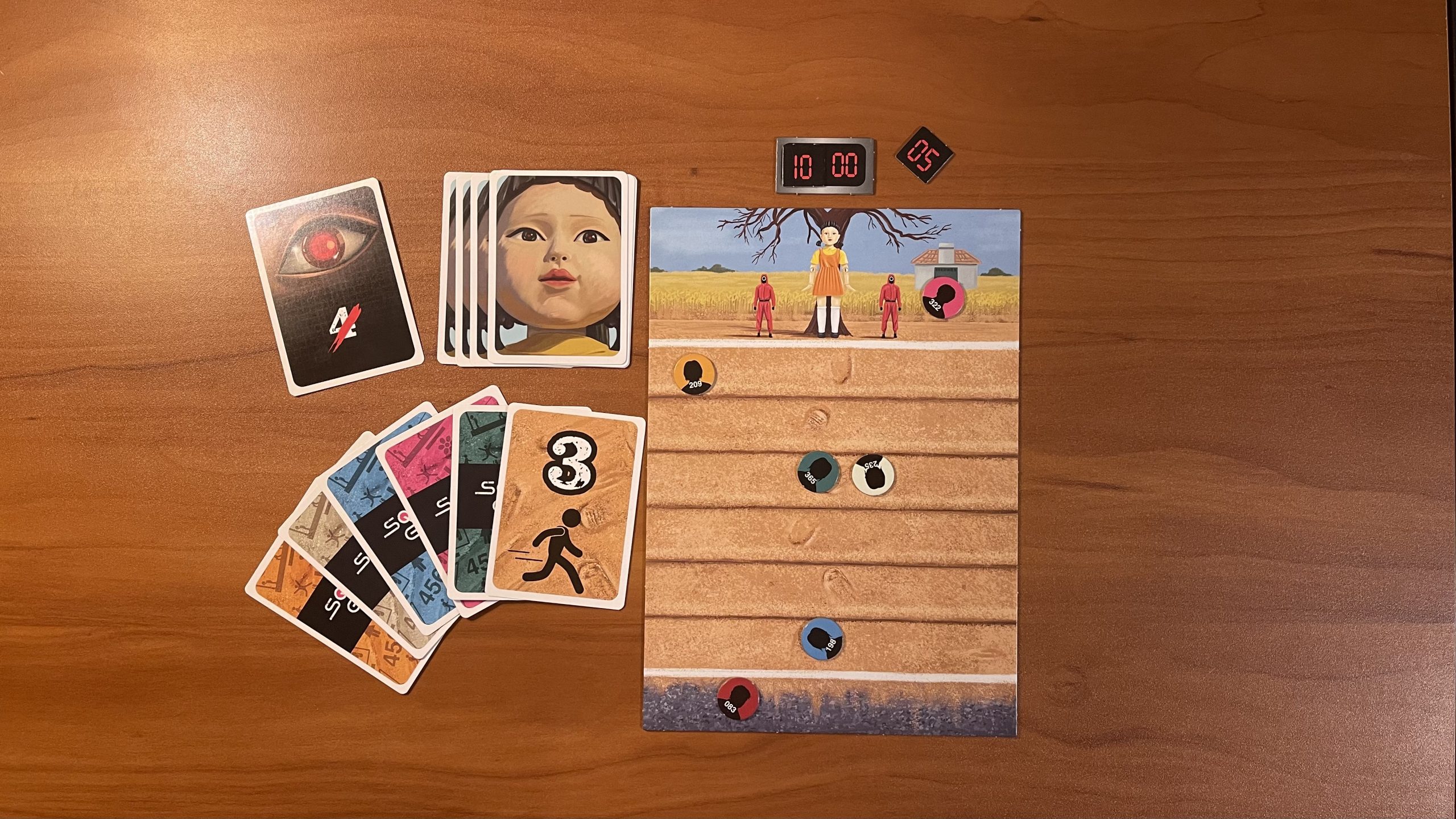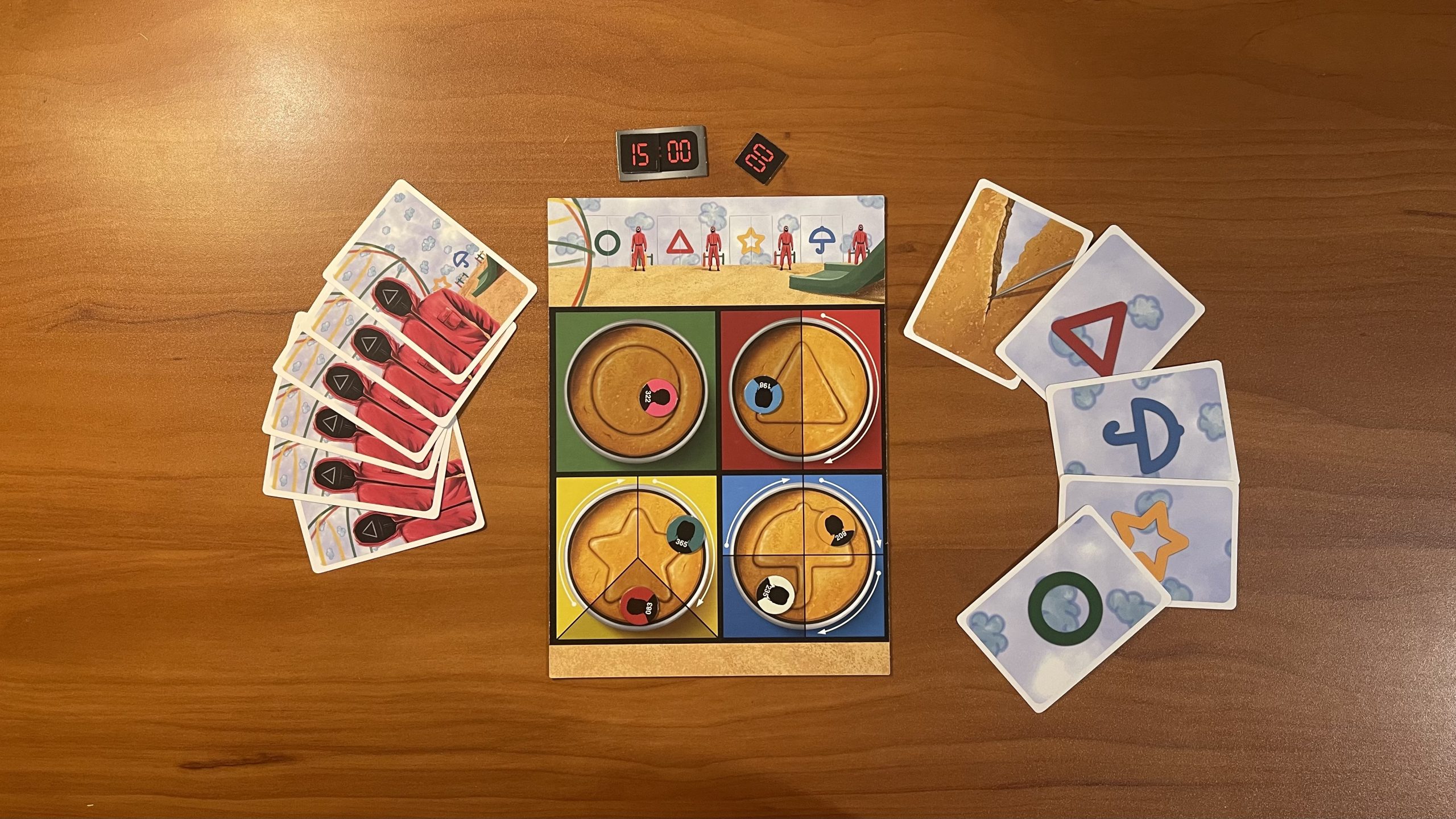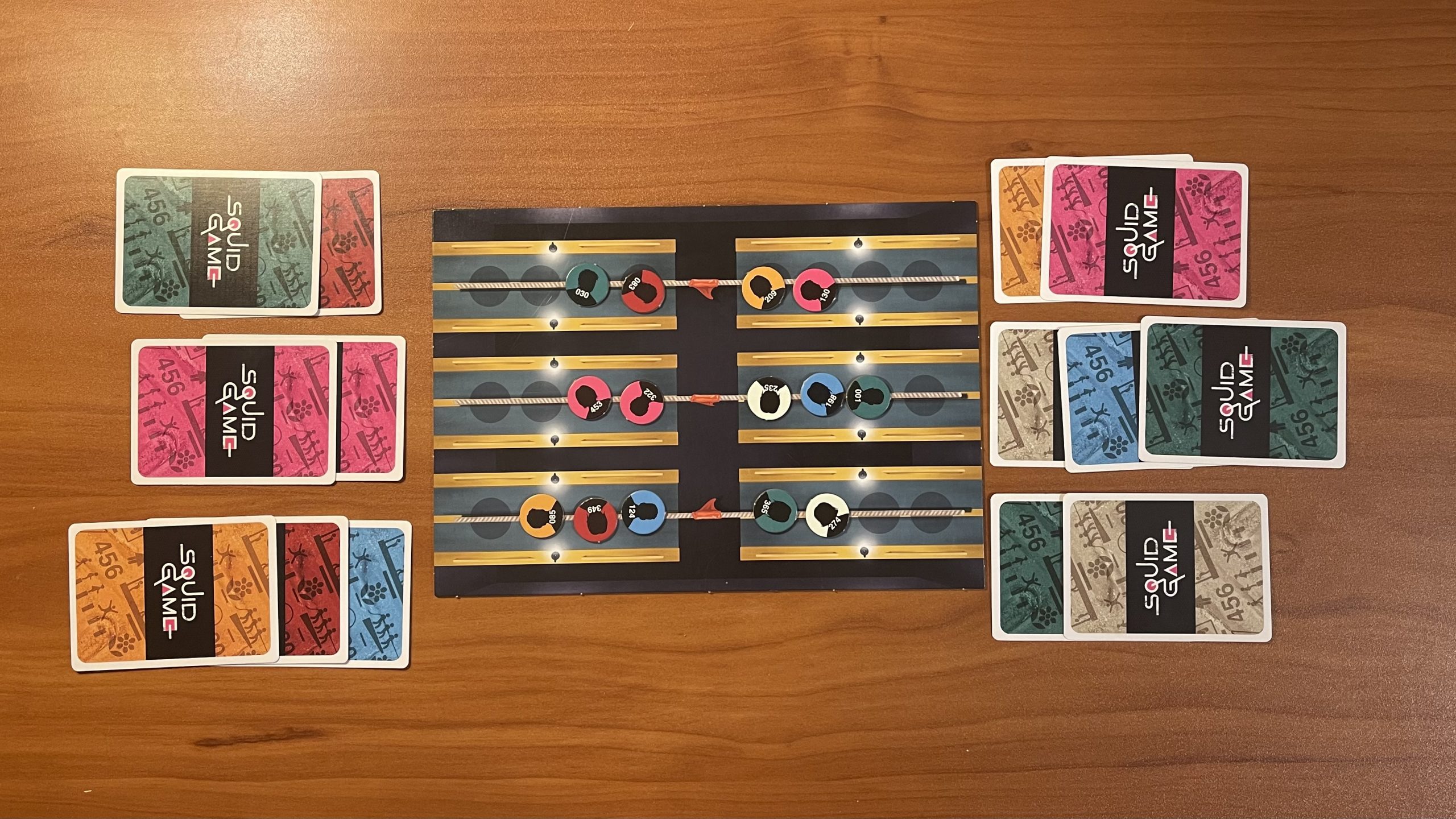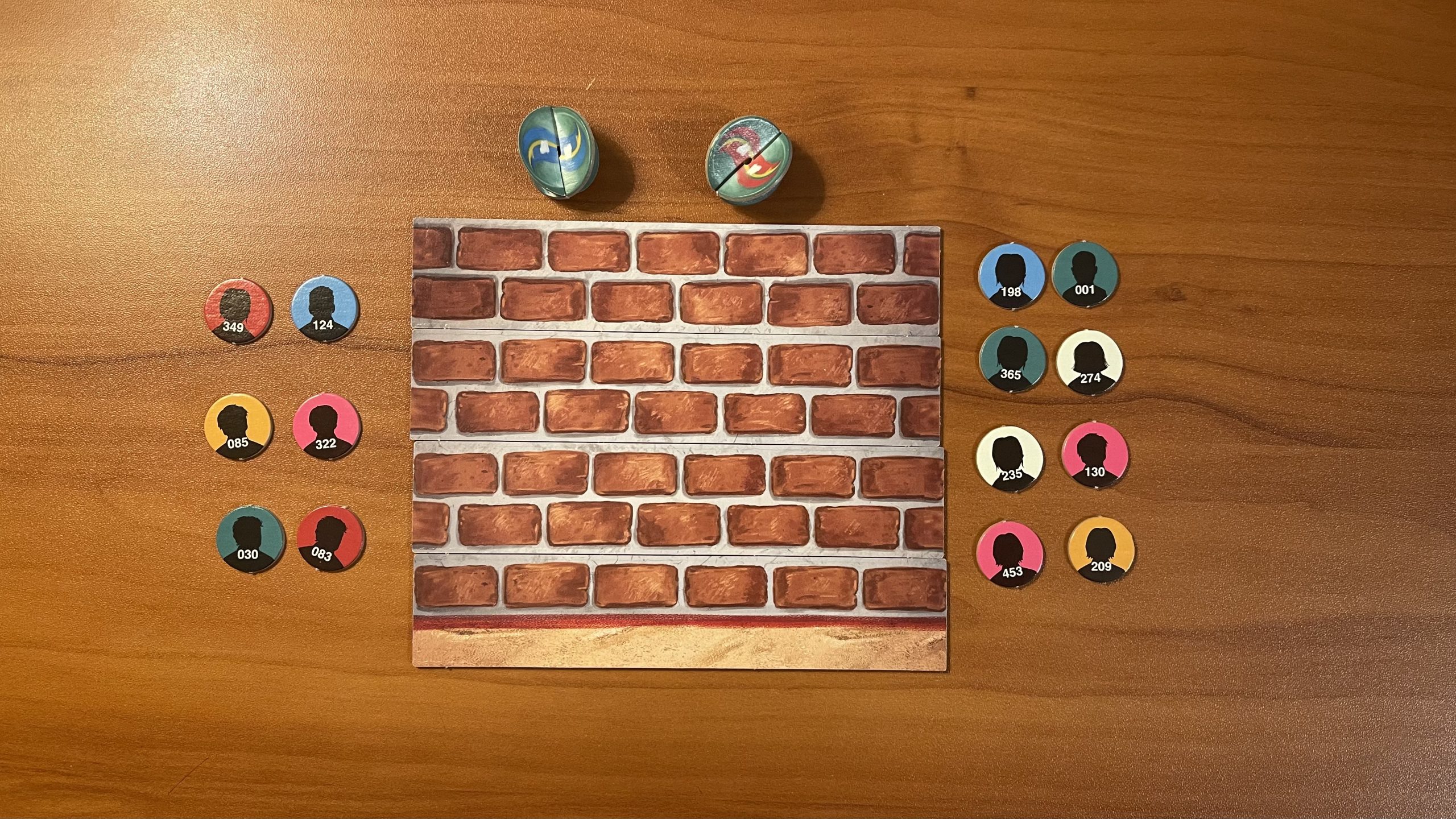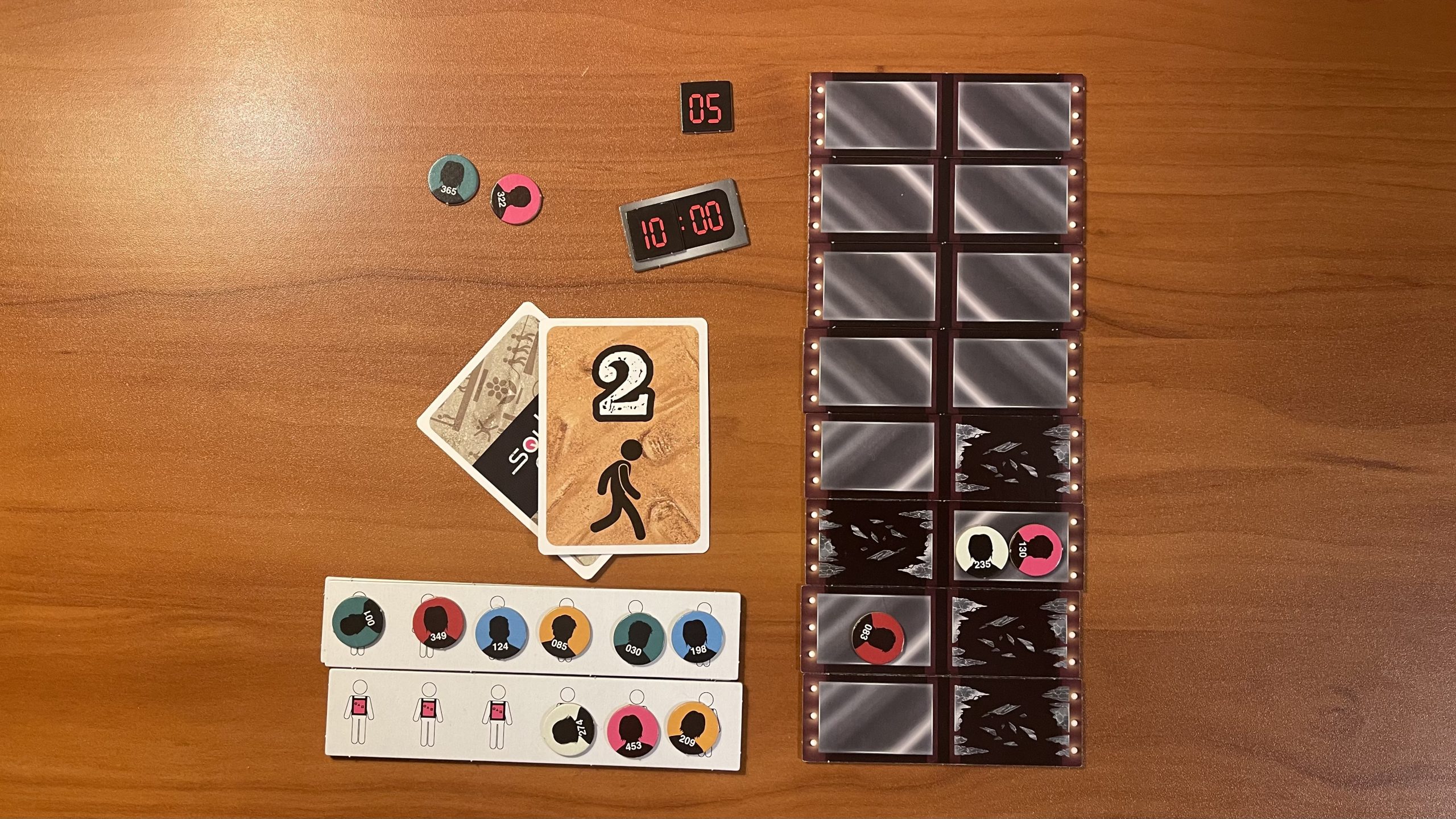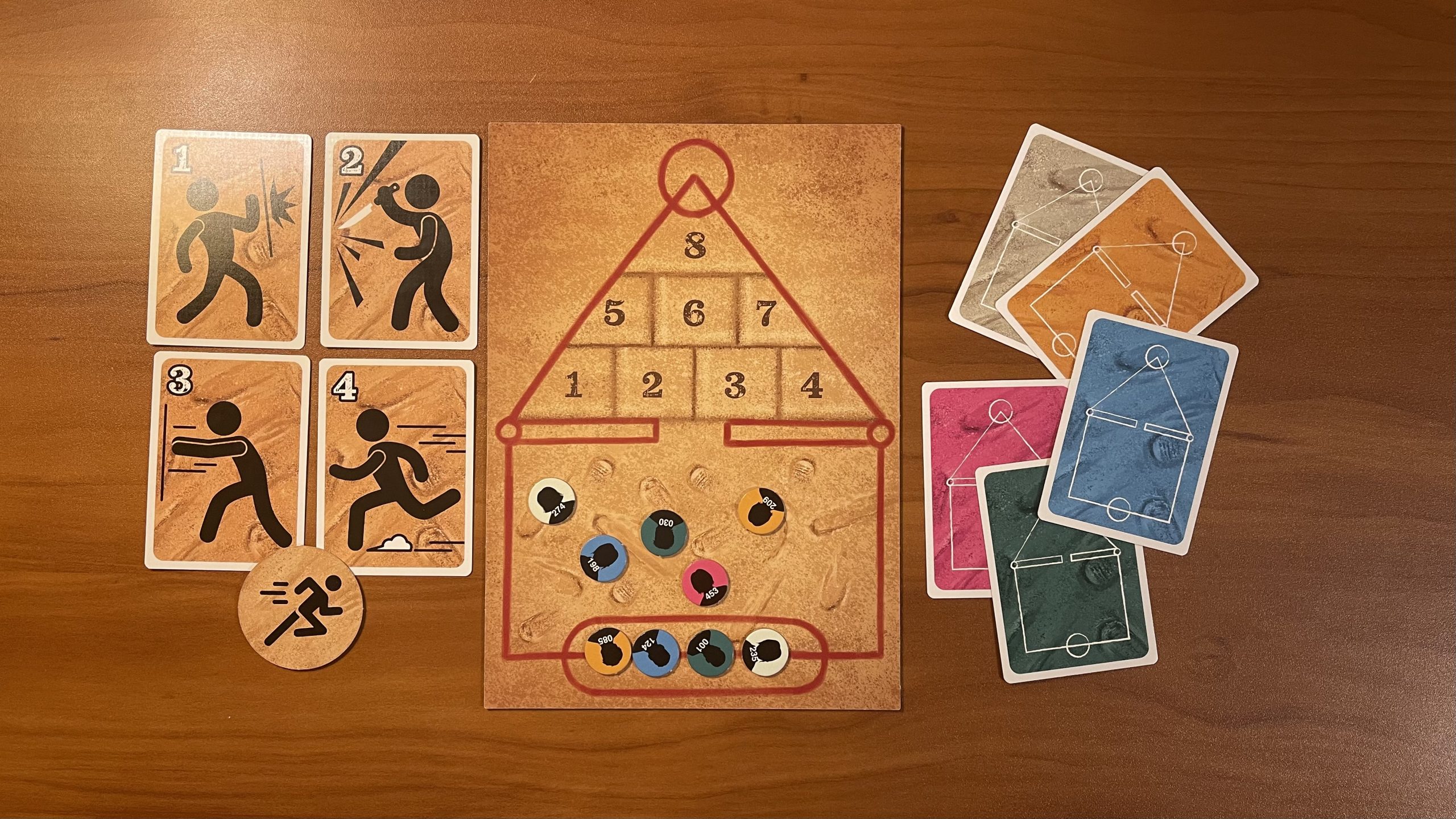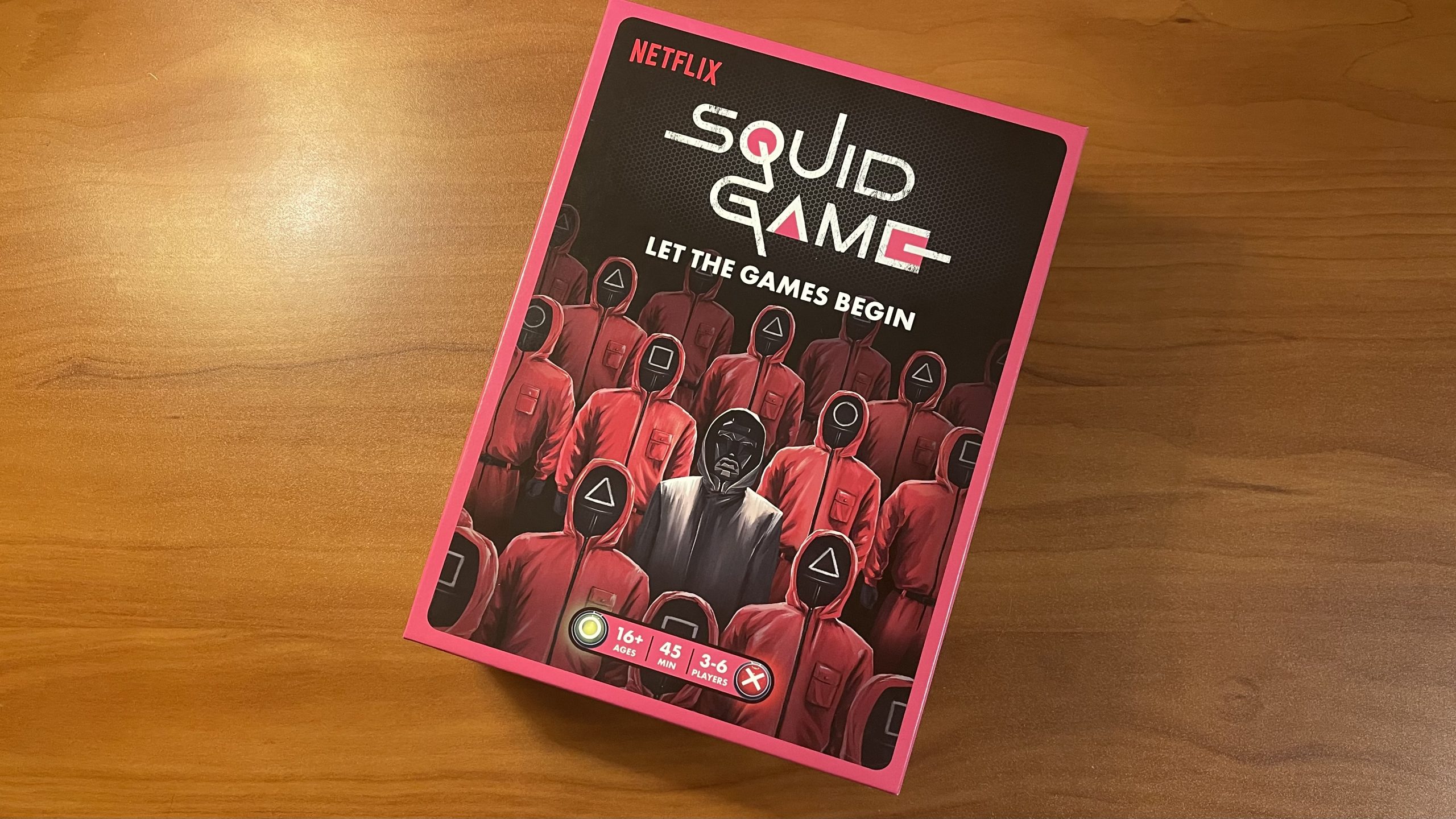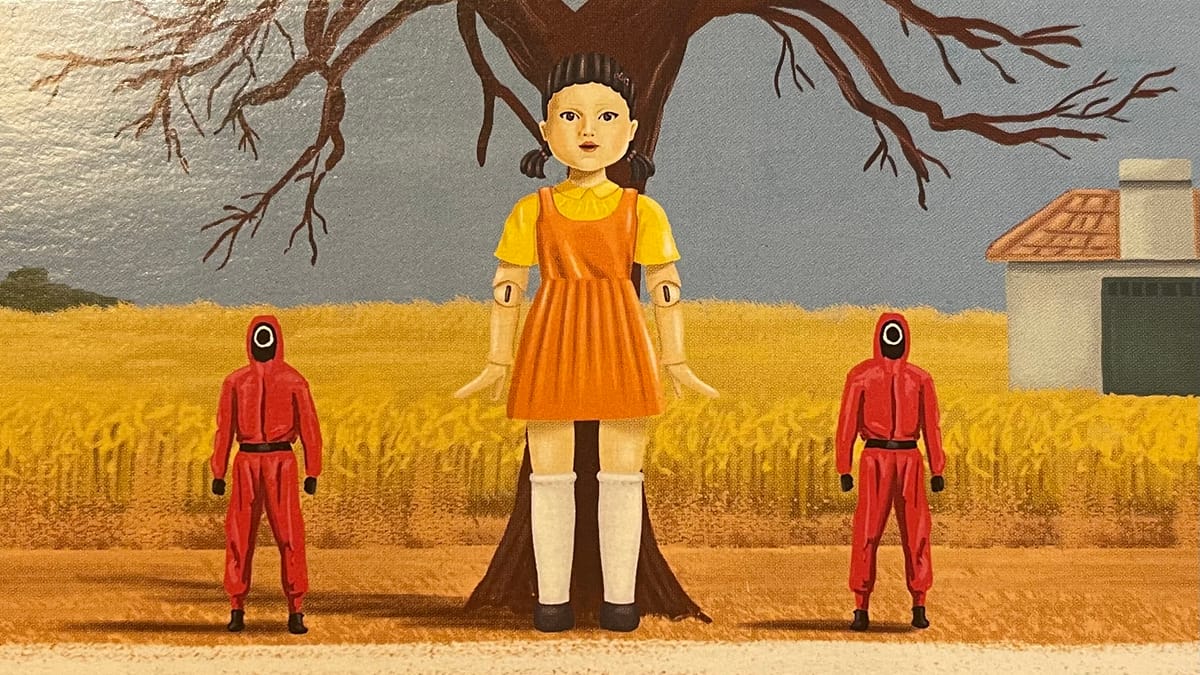
In late 2021, the hit Netflix series Squid Game took the world by storm. A dystopian future story, those desperate for money accept invitations to take part in a series of games, however losing is a fatal error. It sat perfectly alongside films like The Hunger Games, Maze Runner, and Divergent. While some might like to think they could survive such a sick and twisted reality, I’m sure we can all agree that we’d prefer to take part in the games with a lot less risk, but lets face it, we can’t all be in a Mr. Beast video. Created by Mixlore and manufactured by Asmodee, Squid Game The Board Game gives fans of the tv series their chance.
Squid Game The Board Game has players compete in a series of mini-games. Each player chooses a team color and takes control of 12 team members, represented by 12 tokens of the respective color. The objective is to keep as many members of your team alive as possible to play in the 6th and final mini-game, The Squid Game, where the first token (team member) to reach the top wins. Players start with 7 of the 12 tokens, and they recruit one token after each mini-game, so everyone gets to participate in every mini-game.
The first mini-game players face is Red Light, Green Light. A makeshift timer is set to 15:00 at the beginning of the game and each player places a team member at the starting line on the mine-game’s board. Players then take a card from their movement deck (which really isn’t a deck as it’s only 6 cards) and reveal their first move. Depending on the card pulled, players can move anywhere from 0 to 4 spaces up the board towards the finish line, that is if the doll doesn’t ‘spot’ them moving.
Before players can move, a card is drawn from the Doll deck. If the card drawn shows a red eye and a number (or numbers) crossed out below, any player(s) who drew the corresponding movement card eliminates the team member closest to the doll. If the card drawn shows a red eye with all four numbers crossed out below, all players eliminate their team member closest to the doll. However, if the card drawn shows a green eye, all players get to proceed with their indicated movement. If you managed to draw a 0 as your movement card, you don’t get to advance any team members, however you can ‘push’ an enemy team member, eliminating them from the game. Once all movements and eliminations have been completed, players place a new team member token at the starting line, and play continues. Players place their movement card back into their deck, however, the doll card is set aside instead.
So, how does the timer factor into this? Well, in the Squid Game tv series, Red Light Green Light was just part of the game. Players had to make it across the finish line in a certain amount of time, or they would still be eliminated. Likewise, in Squid Game The Board Game, if any of your team members are still on the board when the timer hits 00:00, they are eliminated. The timer advances every time the doll cards have to be reshuffled. The timer goes from 15:00 to 10:00 to 05:00 to 00:00, which is actually still a pretty decent length of time considering there are 7 doll cards and players can move up to 4 spaces at a time. (This game is really meant to thin the herd, so to speak, so don’t be surprised if you lose a lot of team members in this first game.)
Any team members who survive Red Light Green Light get to move onto the second mine-game, Dalgona, more commonly referred to as the cookie game. Now, players aren’t given an actual cookie, that would get messy fast. Instead, players take turns placing their ‘living’ tokens on shaded areas of the four different cookie designs on the next board. A new set of cards comes into play with this game. The objective is to have your tokens complete a rotation around the cookie they are placed on by drawing the card that pictures that cookie. There are 11 cards total, and each shape requires so many of its card(s) to be drawn. The circle cookie needs only 1 card to be drawn, the triangle needs 2 cards, the star needs 3 cards, and the dreaded umbrella needs 4 cards.
Only one token moves at a time, however, if you don’t have a token on the card you drew, you “kick the lighter” and select another player’s token to advance instead. There are 10 shape cards, so what’s card 11? You crack your cookie and eliminate one of your tokens on that cookie. Again, the timer comes into play, starting at 15:00 and counting down after everyone has had a turn. Any tokens still on the board when the time hits 00:00 are eliminated.
The third game is Tug of War. After players have recruited a new token to their team, players will take turns placing their remaining tokens on either side of 3 tug of war ropes on the Tug of War board, having up to 4 on each side of a rope (depending on how many survivors there are), though one side cannot have more than 1 more team member than the opposing side. The movement cards from Red Light Green Light come back into play for this mini-game. A card is drawn for each token and placed at the end of the rope(s) the tokens have been placed along. Once all cards have been placed, they are flipped over and then the numbers on the cards are added up. For each rope, the side with the highest total wins and the losing tokens are eliminated. This is easily the fastest and easiest of all the mini-games as it is a single round.
Mini-game number 4 is Marbles. For this mini-game, players create competing pairs with their tokens and then take turns playing “Odd or Even” or “Closest to the Wall”. If there is a token that has no one to pair with, that token survives automatically. “Odd or Even” is pretty simple. If it’s your turn, you take the marbles in your hands and then hold either one or both of them in your fist. The other person then has to guess how many you are holding, odd or even. If they are correct, your token is eliminated. If they are wrong, their token is eliminated. For “Closest to the Wall,” a wall board is used, and the objective is to get the marble as close to the edge of the wall without it going over the edge. Whoever is closest, or whoever doesn’t overdo it, wins. Pairings continue doing either of these until half the tokens have been eliminated. This was a quicker mini-game as it is also only one round.
Honestly, just use actual marbles if you have them, or really anything small and spherical. The ‘marbles’ they give you are just two small cardboard pieces that are supposed to connect together, but they constantly fall apart anytime you touch them, especially when doing “Closest to the Wall.” You could also try taping or gluing them together if you don’t have anything to substitute, though frozen peas would probably work, if you need ideas…
The next mini-game is the iconic Glass Bridge. Eight pieces of ‘glass’ panels are placed with the sides showing which sides are broken facing down. The number of panels placed depends on how many tokens are remaining after players have recruited their new team member, with fewer panels being used the fewer tokens have survived. Mannequin strips are used to determine the order people will step out onto the bridge. Players take turns placing their tokens on the mannequins and then everyone draws a movement card to determine which end of the lineup goes first; if the total of the cards drawn is even, then the bridge is placed to the right of the tokens, and is placed on the left if the total is odd.
However, this is where the rules seem to contradict themselves, or maybe we just misinterpreted them, because it didn’t seem very clear. The rules say that you don’t know which end of the mannequin strips goes first and which is last until all tokens are placed, however, after the bridge is placed on whichever side it ends up on, players are then instructed to draw another movement card to determine who actually goes first. We just decided to go along the mannequin strip for simplicity’s sake.
Obviously, the objective here is to reach the end of the glass bridge without falling through a broken panel or before time runs out. Players take turns drawing a movement card and move one glass panel set at a time, flipping over each new panel to determine if they’ve stepped on a broken side or not. If you stepped on a broken side, that token is eliminated, regardless of if they’ve made the indicated number of moves. You made a wrong step, here’s your misfortune. Players keep taking turns based off of the order of the tokens along the mannequin board (that’s how we did it) until everyone makes it across, falls through, or the timer runs out. Of course, anyone still not past the final panel by the end of the timer is eliminated, with the timer ticking down after everyone has had a turn for each token.
With that, we’ve come to the final mini-game, the titular Squid Game. This one was probably the most confusing of all to figure out, but I’ll do my best to try to explain it. Players recruit their 12th and final team member, which may be all they have left after the last 5 games. The objective is to be the first to get one of your tokens to the top of the Squid board. If you get there first, you win! However, getting there isn’t as straightforward.
A new set of movement cards is in play for this game. Each player has a set of four cards, each card showing a different action to be taken. Everyone places a single token in the big square on the board and any additional tokens are placed in the oval-shaped safe zone below that. Tokens in this safe zone cannot be affected by attacks made during play. Let’s get into that part.
The player with the least number of tokens is given the Speed Token. Players draw one of their four cards and action is taken in a specific order. Card 1 is the Block, this player cannot be stabbed. Cars 2 is Stab, the player can shank a vulnerable enemy token, eliminating it. However, you cannot stab someone who has also drawn a Stab. If the only player remaining drew Block, your token is eliminated. Card 3 is Push, which means you can push a token that is Blocked out of the board, eliminating it. The pushed token has to be in the same zone (either both in the triangle or both in the square). Card 4 is Move, which has three options that can be taken; move a token from the safe zone to the square, move a token from the square into space 1 on the triangle, or move a token in the triangle to the next numbered space. After all movement cards have been actioned, every token still alive (not in the safe zone) moves one space forward in the triangle, including the token that used Move to get into the triangle.
There is no timer for this mini-game. The Speed Token is passed clockwise around the table, with the player holding the Speed Token going first if multiple players draw the same card. Play ends when a token reaches the end of the squid and the Squid Game winner is determined.
After peeping at some of the comments others had to say about this game, I went into it with low expectations. I am happy to report, however, that I disagree with most of the negativity this game got from some people. We played Squid Game The Board Game a couple of times. The first time around was so confusing, but the second time around went much better since we had a slightly better understanding of what we were doing. Each playthrough will likely take your group around an hour, depending on the number of people playing and how bad your RNG is. The game isn’t particularly skill-based, it’s really just the luck of the draw.
The game comes packaged in a nice little box with iconic Squid Game art. Removing the top of the box shows the inner contents, but a nice detail that was revealed upon opening was that the six mini-games are briefly explained around the outside of the bottom part of the box. Inside, you are immediately presented with a simple rule book that explains each mini-game in further detail, although, as mentioned before, not always in ways that make sense. After that are two double-sided game boards, each side for different mini-games, the mannequin strips, the flip sides of which are used to build the wall for Marbles, the panels for Glass Bridge, and then the punchout cardboard tokens, the different cards, and “marbles”.
The cards are made of the same material you’d find for a standard 52-card deck, so they aren’t easily damaged and are easy to reshuffle. Over time you may want to put them in sleeves to prevent the inevitable wear and tear from repeat usage, however I doubt you’ll actually play the game enough to get to that point. All of the cardboard pieces are fairly durable as well, however I wish the boards for the mini-games were bigger. They’re about 8.5 inches long and a little over 6 inches wide. I’m not saying they need to cover the dining room table, but making them at least the size of a letter-sized piece of paper, however minimal a difference it may seem to some, would actually give players more space to work with when maneuvering tokens. And, as mentioned previously, the “marbles” should’ve just been actual marbles or another spherical thing that doesn’t fall apart when the wind blows.
Overall, Squid Game The Board Game is a decent enough party game for 3 to 6 players, though I definitely recommend more than 3 to make things more interesting and to keep things better balanced. With only three players, especially during the first mini-game, we saw nearly every token get eliminated, which could have been slightly alleviated if we’d had more players. The second time around, we all decided to take control of two teams each, which definitely made things more interesting. As for the rule book, I feel like some things were over complicated and could have been simplified, especially at points where it felt rules contradicted each other, like in Glass Bridge.
Squid Game The Board Game
Good
Squid Game The Board game is a decent party game for 3 to 6 players that allows fans of the beloved Netflix series to experience the games without the risks of losing. The game is made with quality materials (except the 'marbles') and is presented in iconic packaging Squid Games fans will be quick to recognize. However, the rules were sometimes hard to follow and could have been simplified for a much more enjoyable experience.
Pros
- Squid Game without real danger
- Quality materials and iconic design
- Not too long, not too short
Cons
- Rules could use some serious reworking
- Mini-game boards could’ve been bigger
- The “marbles” are terrible, give us real marbles!
